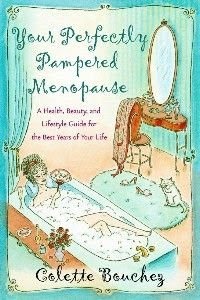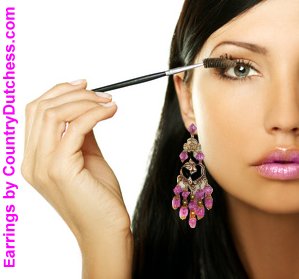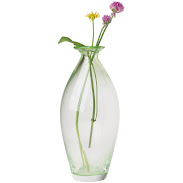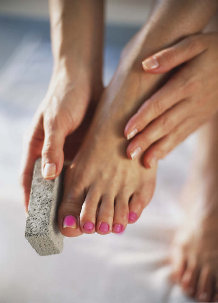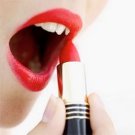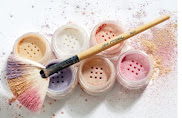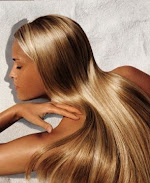
The look of the season: Natural, glowing, glistening skin – with nary a flaw the eye can see.
How do you get it? Well you could jump in your backyard time capsule and dial in 1975. Or....you could try mineral make-up!
Indeed, among the strongest trends going forward in Summer 08 beauty are highly purified loose mineral powders formulated into foundations, blushes and eye shadows and available in a dazzling array of colors.
Among their biggest draw - highly dense pigments that some say offer better coverage than traditional foundations while feeling lighter - not to mention being kinder and gentler to your skin.
"Because the base of mineral makeup is titanium dioxide and zinc oxide which have natural anti- inflammatory properties, it can have a calming effect on the skin and for many people it won't aggravate conditions like acne or rosacea," says Dr. Kathryn Frew, a dermatologist at Juva MediSpa in Manhattan.
These same two minerals are also natural sunscreens , so most mineral make-up has an SPF of 15 – or higher. Bare Minerals, which some credit as the pioneer of mineral make-up, even carries a seal of approval from the Skin Cancer Foundation.
At the same time, however, it's important to point out that not all mineral makeups are alike.
First, some can be very drying to over-40 skin, and it can accentuate some fine lines and wrinkles.
But perhaps more important, while virtually all the brands claim the benefits of natural good-for-your-skin ingredients, a little under cover make-up investigation has revealed this isn't exactly the whole truth.
Not All Mineral MakeUp Is Alike!
First developed in the mid 1970's, the original intent of mineral makeup was to do away with the otherwise irritating fragrances, dyes and preservatives found in traditional cosmetics.
Today, however, it seems not all companies play by these unspoken rules.
In fact, since there are essentially no regulations governing what constitutes a " mineral makeup", manufacturers actually have license to cheat. And many of them do.
"Some mineral products contain less of these irritating ingredients than traditional makeup but some can contain as much or more, so don't rely solely on the term 'mineral' - you really have to read the entire label to see what you are getting," says Frew.
Tips offs include ingredients such as methylparaben and propylparaben, preservatives that are not natural, and some say are linked to health concerns.
But even amongst those that offer all- mineral formulas, there's another dividing line: Products that contain the ingredient "bismuth oxychloride" and those that don't.
While it sounds like a mineral, technically it's the result of processing lead and copper and mixing it with a byproduct of chlorine. Some companies use it as a filler or to give products a pearlized glow and a nice anti-aging effect.
But purists like Kristen Adams, president of Afterglow Mineral Make-up, says looking young and dewy has its price.
"We don't use bismuth oxychloride because many women are allergic to it and either break out and/or itch - plus we prefer the more semi-matte look of the non-bismuth formula," says Adams.
Frew says when used in significant quantities bismuth oxychloride can irritate acne and rosacea, so if you have these problems try to avoid it, or check to see how far down on the ingredient label it is – lower is better.
In attempts to capture our attention and dazzle us with science, some mineral make-ups are also touting "extras". Jane Iredale includes the anti-aging antioxidant protection of pomegranate, pine bark and algae extract, while TRUE offers the pricey anti aging ingredient idebenone. Drugstore line IsaDora tempts us with the decadence of real crushed amethyst, citrine and aquamarine, said to improve microcirculation and offer other skin-health benefits.
But do the extras really matter?
Experts say they might offer some surface benefits – but since make-up is designed to sit on the skin, and not penetrate it, don't buy it for the extras alone.
Says Frew: "Find the product that looks best on your skin and is the easiest to apply."
To learn how the 5 leading brands of mineral make up stack up - and what each has to offer, click here.
You might also enjoy reading 23 Ways To Prevent Wrinkles (click here) or "More Hope In a Jar: The Anti Aging Ingredients That Work (click here).
Thursday, June 26, 2008
Mineral MakeUp Uncovered !
Tuesday, June 24, 2008
New Studies Reveal Summer Foods That Fight Disease
 You know how I just love to pass a long good food – good health tips – and this week we have a bumper crop of new studies showing that when it comes to disease prevention, your summer picnic basket may be your body’s best defense!
You know how I just love to pass a long good food – good health tips – and this week we have a bumper crop of new studies showing that when it comes to disease prevention, your summer picnic basket may be your body’s best defense!
In fact, if you’re someone who’s always looked at the word “diet” as a means to shave off a few pounds so that red dress fits a little better, then it’s time to update your good health vocabulary.
Today, diet – or more precisely our daily eating habits – increasingly play a role in not just how we good we look, but also how good we feel.
And it’s not just the foods we avoid that matter. Certainly reducing your intake of trans fats and saturated fats is important. But so is increasing your intake of some of the foods that research shows can cut your risk of disease – including cancer.
So get ready for a summer picnic of delicious, health-preserving foods!
 Cut Colon Cancer Risk 76% With Iced Tea!
Cut Colon Cancer Risk 76% With Iced Tea!New research shows that natural compounds found in tea as well as several fruits and vegetables have a direct impact on reducing the risk of advanced colon cancer –up to a whopping 76% for some!
The new report featured in this month’s journal Cancer, Epidemiology Biomarkers and Prevention focuses on a natural compound known as flavonols found in fruits and vegetables. But if you think you’ve heard it all before, guess again.
This study found that overall fruits and veggies rich in compounds known as flavonoids – like Brussels sprouts - aren’t all that effective on colon cancer prevention. But, when you look deeper at a subgroup of foods containing compounds called “flavonols” - you get a much different risk reduction picture, particularly when it comes to colon cancer.
The new National Cancer Institute study involved over 2,000 men and women who were randomly assigned to either a low fat, high fiber, fruit and veggie-rich diet, or a “normal” diet.
After factoring out the effect of fiber, as well as taking into consideration each patient’s age, BMI, gender, and even the use of non-steroidal anti-inflammatory medications (all of which can influence the risk of colon cancer) researchers found that a higher intake of not only fruits and vegetables containing 6 key flavonols, but also tea - resulted in a 76% reduction in the recurrence of advanced colon tumors.
This backs up a 2006 Italian study reported in the same journal which found that overall, the risk of colon cancer could be reduced by as much as 40% in healthy folks.
According to the World Health Organiztion 1 million new cases of colon cancer are diagnosed world-wide each year, with genetics accounting for less than 5 percent.
To discover the other flavonol-rich foods to toss into your picnic basket – and the picnic basket recipes that use them - click here.

 Stop Arthritis With Pomegranates
Stop Arthritis With PomegranatesSome say that pomegranates were the true forbidden fruit in the Garden of Eden! But today scientists say that this juicy sweet-tart California treat may give you the same kind of anti-inflammatory protection against arthritis pain, as drugs known as Cox-1 and Cox-2 inhibitors – without the risk of stomach bleeding and upset.
Writing in the Journal of Inflammation, researchers from Case Western Reserve University in Cleveland, found that several key substances found in pomegranates appear to reduce inflammatory-related breakdown of the protective cushy cartilage between bones – a major cause of osteoarthritis - as well as reducing the production of inflammatory factors related to arthritis pain and progression.
More specifically, the study found that not only were blood levels of antioxidants substantially higher after animals were fed extracts of pomegranates, at the same time levels of inflammatory chemicals known as COX-1 and COX –2 - were reduced by as much as 26%. These are the same chemicals targeted by some of the arthritis pain medications recently taken off the market.
The researchers say that in time, pomegranates may become a realistic alternative to NSAIDs – non-steroidal anti-inflammatory drugs – medications that also work to reduce inflammation, but have been linked to an increased risk of gastrointestinal bleeding.
Previous studies have also linked pomegranates to heart health and protection against prostate cancer.
For terrific summer recipes using pomegranates, click here!
 Eat Cranberries – Reduce Ulcer Risk
Eat Cranberries – Reduce Ulcer Risk By now you probably know that cranberry juice can help reduce the risk of urinary tract infections. But the really big news is that it may also help eradicate the bacteria linked to ulcers – specifically the Helicobacter pylori – or H-pylori infection now believed to be a significant cause of peptic ulcers.
In a report published in the current issue of the journal Nutrition, researchers write that cranberry juice as well as a probiotic or “good “ bacteria known as lactobacillus johnsonii were effective in reducing levels of H-pylori bacteria in the gastrointestinal tracts of children between the ages of 6 and 16 – by as much as 23% compared to just 1% in the control group.
The multi-center randomized, double blinded placebo controlled study involved 271 children with documented H-pylori infections. The research pitted cranberry juice alone, vs. cranberry juice infused with the probiotics, vs. several placebo combinations. The children drank the juices – about 200 ml – daily for three weeks.
The result: Both the lactobacillus and the cranberry juice drinks worked well against the H-pylori bacteria – but if you’re thinking that the combination of the two will pack an even greater punch, stop right there! The study also found there was no statistically significant boost in healing when the two were combined.
In addition to being leading cause of ulcers, H-pylori bacteria is also linked to gastritis, and those infected with the bacteria have an increased risk of developing a specific type of lymphoma as well as gastric cancer.
Previous studies have reported that cranberry juice as well as probiotics can prevent many types of harmful bacteria from clinging to tissue in the mouth, as well as the urinary and gastrointestinal tracts.
For a delicious cranberry cooler recipe that will quench your thirst and protect your tummy, click here.
K
 iwi Fruit Boosts Immunity
iwi Fruit Boosts ImmunityFinally, when packing that picnic basket be sure to toss in a few kiwi fruits – those sweet little green treats native to California. Indeed, new research published this week in the journal Food and Agricultural Immunity revealed the power of kiwi fruit to help the body manufacture antibodies and other immune cells used to identify and destroy processes that would otherwise be harmful to our health.
The well-controlled animal study conducted by scientists at Bioactives Research New Zealand, found that mice that nibbled on kiwifruit produced significantly more antibodies against two different types of vaccines than the mice that had no kiwi desserts.
Experts attribute the protective effects of Kiwi to their high vitamin C and E content –which is much greater than most other fruits. Kiwis also contain a high but well balanced level of carotenoid antioxidants, which have been found to boost resistance to disease. Finally, kiwi fruit is also high in fiber making it a good choice for helping to control blood sugar and aid the gastrointestinal tract. Find a great summer kiwi recipe here.
For more information on the foods featured in these studies – including tantalizing summer Here’s To Your Health recipes visit www.RedDressDiary.com.
Friday, June 20, 2008
Sunscreen Caution: Are You Really Protected?
Unfortunately, unless you know what to look for in a sunscreen, you may not be getting the protection you think.
The reason? Many of the products sold today can only offer long lasting protection from the short length UVB rays of the sun.
And while that’s important – these are rays responsible for that nasty, painful sunburn - research now shows that it’s really the long length UVA rays that may be the most damaging of all.
These are the rays, say experts, that cause not only the kind of deep, penetrating cell damage that increases your risk of skin cancer, but also increases the kind of damage that linked to premature skin aging.
"UVA rays penetrate deep, not only increasing your risk of skin cancer but also causing the kind of deep collagen and elastin damage that contributes to aging skin,” says Bruce Katz, MD, director of Juva Skin and Lasers in New York City.
What’s that you say . . . your sunscreen says UVA and UVB protection?
Here’s the glitch: While the UVA protection offered in most sunscreens does work – it is effective for only a short time, in some studies offering protection for as little as just 20 minutes.
Indeed, a combination of sweat and the sun itself causes many of the most commonly used UVA defenders to degrade soon after they are applied, leaving you vulnerable and at risk faster than you can down that can of diet soda on your lunch break in the park.
Another note of caution: Don’t look to the SPF (sun protection factor) of a sunscreen a measure of its total effectiveness. The SPF is a determination of how long you can remain in the sun before you will get burned – and so it reflects only the protection from UVB rays.
The SPF of a product has no bearing on UVA exposure– so no matter how high the number, the product won’t necessarily offer you the protection you need.
 Good News: The UVA Protection That Does Work
Good News: The UVA Protection That Does WorkFortunately, you don’t have to spend the summer hiding in the basement- or worse still, bopping around town with one of those ruffle- y pink parasols doing your best impression of Scarlet O’Hara in Gone With The Wind.
Instead, look for sunscreens that contain one of two key ingredients: Helioplex or Mexoryl sx (emcamsule). Hailed by the medical profession as the first real breakthroughs in sun protection in more than 20 years, each of these ingredients is designed specifically to defend skin against those short but deadly UVA rays with protection that lasts.
"These two ingredients are truly the best we have and they are a major, major advance in not only sun protection but also in protection against premature skin aging, “ says Katz.
Mexoryl SX contains the unique UVA blocker emcamsule. Developed by the scientists at L’Oreal it is currently available in several sunscreen formulations, as well as being included in a number of anti-aging creams designed to both treat and protect the skin at the same time.(Click here to learn more.)
Helioplex, is a technology developed by Neutrogena and it works to stabilize two traditional sunscreen ingredients - avobenzone and oxybenzone- so the UVA protection they normally offer does not break down. And that means protection that lasts, without having to reapply as often. (Click here to learn more).
Whichever ingredient you choose, you’re sure to end up with a sunscreen that both protects your health – and helps you look younger longer. What’s not to love?
For more information on the specific sunscreens with this top-level protection click here.
Wednesday, June 18, 2008
Respecting Obesity With New Legislation
 We all know that being overweight carries some serious health consequences. Heart disease, diabetes, high blood pressure, even cancer have all been linked to carrying around those extra pounds – and the more we carry, the greater our risks.
We all know that being overweight carries some serious health consequences. Heart disease, diabetes, high blood pressure, even cancer have all been linked to carrying around those extra pounds – and the more we carry, the greater our risks.
Still as important a health condition as being overweight is, when it comes to products and services designed to help us beat it, all sense of propriety seems lost.
In short, nowhere do we see more unproven, untested “remedies” for a serious health concern than we see being offered to those who are overweight.
Indeed, the Federal Trade Commission recently reported that more Americans are duped by phony weight loss claims than by any other types of products they evaluated.
In fact, as anyone whose tried to find a weight loss solution can tell you, there are a litany of dietary supplements, quick fix electronic exercise equipment, fat burning teas, nose spray appetite suppressants, as well as any number of lotions, potions or treatments alike, all promising to get rid of the fat - without any real evidence they can deliver on the promise.
Among the biggest offenders of all: The book publishing industry. I’m speaking about the barage of diet books published each year, most without so much as a chard of evidence that they work.
Think about it … be it large publishers or small, these books are continually offering us treatment plans for a serious, life threatening condition - obesity - devised by celebrities, super models, or self-proclaimed experts in the field! Most have little or no formal nutritional, dietary or weight loss education or experience, and I’d venture to guess almost none of the protocols have ever been subjected to the kind of double-blind, placebo controlled testing required of treatments for other serious illnesses.
Would you even dream of subjecting your child, your spouse, your siblings or yourself to a untested, unproven treatment for cancer or heart disease devised by a movie star?
And yet, somehow the book publishing industry seems to have convinced us it’s okay to try these largely unproven regimens if we are obese - and to blame our selves, and not them, when their plans fail. As almost all do.
But all this however, may soon change, thanks to one group of health professionals determined to give obesity – and those who seek treatment - the same kind of respect offered to other serious health concerns.
At the core of the movement: The American Dietetic Association, the Obesity Society, Shaping America’s Health and the drug manufacturer GlaxoSmithKline, who have joined forces to create a “citizen’s petition” – a request made directly to the FDA calling for greater scrutiny of products aimed directly at those struggling to lose weight – particularly dietary supplements.
“ Specifically, petitioners request FDA to treat weight loss claims as disease claims because such statements purport to prevent or treat an abnormal or unhealthy condition that, while not itself a disease, is a significant risk factor for disease, “ write the experts in their letter to the FDA.
In short, they are asking the government require those who offer treatments for obesity to be held to the same strict standards of scientific validation now required for treatments of the very diseases linked to obesity - namely, diabetes, heart disease and cancer. And to force those manufacturers whose products don't cut the mustard to stop peddling their wares with promises they know they can't keep.
But while the petition is a great start, there has to be more.
Yes, government legislation will help, but perhaps even more important is that, as a whole, industry, society, and yes, all of medicine, must begin to treat those who are fighting the battle with obesity with the same kind of compassion and respect afforded to those who succumb to it’s consequences. And that respect must trickle down to treatments and solutions.
Friday, June 13, 2008
Eat To Beat Summer Heat
 It's a hot, steamy summer morning – and just getting out of bed can zap a days worth of energy.
It's a hot, steamy summer morning – and just getting out of bed can zap a days worth of energy.
It's called heat fatigue – and if you think you're tired now, broiling summer temps are poised and ready to make you feel even hotter and more tired as the season wears on.
And while you may be inclined to cool your body and boost your energy by downing a giant iced coffee or a heaping portion of gelato every chance you get, experts say this would be the wrong choice.
"Foods that are high in things like sugar and caffeine are designed to give you a momentary boost in energy, but it fades fast, and you're right back where you started – feeling hot and even more tired, usually in under an hour," says Connecticut nutritionist Samantha Heller, RD.
What works a lot better, she says, are snacks that can both quench your thirst, boost your immediate sense of fatigue, but also sustain the feeling of energy for a while.
Among the best choices are a tall glass of icy cold water coupled with a snack of complex carbohydrates, like whole wheat crackers or pita bread topped with a little protein and a little fat, such as peanut batter or a slice of ham.
"You'll have instant energy and it won't be followed by a crash," says Heller.
Fighting Heat Fatigue: More Secret Weapons
While the summer heat may leave you feeling so tired all you can think of is taking a snooze in the hammock, you may be surprised to learn you're not really as tired as you feel. The reason: When temperatures soar experts say that fatigued feeling may really be your body crying out for fluids rather than sleep.
Indeed, studies show that even mild dehydration can cause you to feel sluggish. And if you’re very dehydrated – which can occur faster than you think when temperatures climb - you can feel completely exhausted. And yet it’s really water and not sleep you need.
To help fight summer fatigue, Heller says eat lots of water-rich fruits like watermelon, strawberries, oranges, plums, and peaches. If you also add in a protein source – like low fat yogurt or cheese – you’ll not only quench your body's thirst but also get an extra bit of energy that will keep you feeling awake and alert a lot longer.
Finally, to keep fatigue from setting in after summer sports - or all that summer-sale power shopping – one study from the University of Vermont in Burlington suggests tart cherries may be your secret weapon.
Tuesday, June 10, 2008
Beauty Buyer Beware: Avoid Anti Aging Skin Care Scams
“… a 92% reduction in wrinkles "
" ...clinically proven to firm skin "
“ ...dramatically reduces wrinkles in 7 days "
“Many of these products are claiming changes in the skin that, if they were true, would automatically classify them as drugs requiring FDA approval - and clearly they are not drugs,” says NYU professor and dermatologist Rhoda Narins, MD.
So, says Narins, it's reasonable to assume that many won't deliver what they promise.
And in fact, this was exactly what the magazine Consumer Reports found last year, when they put a number of popular anti-aging treatments to the test. Their analysis showed that a good deal of the anti aging products make huge promises, simply don't live up to their claims.
So, how do these companies come up with all these "test results" touted in the ads?
Well you may be surprised to hear that for the most part, experts say the results in the ads are truthful. But, what they frequently don't tell us is how the testing was conducted - a factor that can make a huge difference in the validity of the results.
" We don't know, for example the parameters under which the testing was done, how the participants skin looked before it started, what the results compared to, if there was any scientific validation of the effect – and all of this makes a huge difference when interpreting statistical data," says Bruce Katz, MD, professor of dermatology at the Mt. Sinai School of Medicine in New York City.
But even if test results are validated by the Research and Development team of the company, experts say you still can't be sure of unbiased results.
Cosmeti c Shopping Tips: Buyer Beware!
c Shopping Tips: Buyer Beware!
That said, there are some companies - and some product ingredients - that do have an impressive scientific pedigree. And they can live up to at least some, if not all of their promises.
5. If a product is only available online - and isn't carried by your local pharmacy, a department store or a cosmetic superstore - think twice before you buy it. Sometimes exciting new products show up Online first. But other times it can be a hotbed of commerce for off-label products that are untested or even dangerous, or not meant to be used by consumers. Again, let published clinical studies be your guide.
One final note of caution: If you're looking to save a few bucks by purchasing name-brand cosmetics on an auction site, be certain to buy only from reputable merchants - particularly those that are US based and with a long history of favorable transactions. While it may seem like you've netted the bargain of a century when a 60 dollar cream is yours for only 24 bucks -remember, if they can counterfeit a Rolex watch, they can counterfeit a jar of cream!
For more help in in finding the anti aging ingredients and products that really work visit:
RedDressDiary.com - The Destination for Fabulous Women Over 40!
Friday, June 6, 2008
Study: You Can "Teach" Skin To Look Young!
 If you feel as if the hands of time have a stranglehold on your wrinkling, aging skin, here’s some news you’ll want to hear: New research shows we may be able to “instruct” the body to make more of at least one biological substance skin needs to look young – and in doing so turn back the hands of time in a major way!
If you feel as if the hands of time have a stranglehold on your wrinkling, aging skin, here’s some news you’ll want to hear: New research shows we may be able to “instruct” the body to make more of at least one biological substance skin needs to look young – and in doing so turn back the hands of time in a major way!
That substance, says experts is collagen. Long believed to play a major role in skin wrinkling, collagen production declines as we age - and for a long time, doctors believed there wasn’t much we could do about that.
But a new report in the current issue of the Archives of Dermatology, says otherwise. Here, researchers from the University of Michigan write that specific advances in skin care made over the past decade have opened the door to the idea that we can "teach" the body to begin producing this vital substance in much the same way it did when we were young.
In essence this means that not only can we stop the hands of time –we have the opportunity to effect a permanent physiological change in skin that can reverse some of the signs of aging - something that has never before been possible.
The best news of all: You don't have to wait a decade or even a year. The study found this was all possible with some dermatologic treatments already in use today.
Old Skin Vs. Young Skin
One of the major differences between “old” skin and “young” skin is the amount and quality of collagen found below the surface. A type of connective tissue, collagen, along with elastin, form a kind of invisible criss-cross netting underneath skin to help support and keep everything in place.
It is, in fact, collagen that gives skin it’s buoyant, dense youthful look and feel, keeping those cheekbones from sliding into your chin and your chin from sliding into your neck - forming a boatload of wrinkles along the way.
But collagen doesn’t last forever. Environmental factors like the sun and pollution – especially chemicals found in cigarette smoke – combine with the natural aging process to damage cells that produce collagen, causing them to become fragmented, or "broken", and no longer able to give skin the support it needs to look young.
The Science of Keeping Skin Young
For a while everyone thought the answer to collagen loss was to simply apply more collagen – as in the explosion of collagen creams hitting the market in the 1980’s. But it wasn’t long before science also realized that collagen applied from the outside wasn’t doing much good on the inside. While skin looked temporarily better, the effects weren’t lasting.
And this is where the new Michigan University research sheds some important new light on some current treatment options.
More specifically the researchers say that when certain treatments make their way to skin cells, they are able to create an environment in which damaged fibroblasts (collagen producing cells) can recover – and begin producing collagen in much the way they did when skin was young! In a sense, these treatments are teaching skin to "act" and eventually look the way it did when we were young.
You can slow down the hands of time – and with the right treatments and products, maybe even reverse some of the nasty effects of aging that have already occurred.
But at the same time, it doesn’t mean you can throw caution to the wind and ignore the things that cause premature skin aging – including sun exposure, smoking, and other lifestyle factors such as a lack of sleep or a nutrient -poor diet.
Experts say all these things still matter, since the longer you can keep your collagen producing cells healthy and functioning, the less repair work you’ll need.
That said, it’s also comforting to know that with the right treatments and ingredients not only can we compensate for some of the damage that has already occurred to skin cells, there is now good evidence to show that at least some of that damaged may be reversible.
To learn more about which specific treatment types the study found to help initiate the production of new collagen, as well as the skin care ingredients shown to effect change visit
the RedDressDiary.com : The Source For Fabulous Women Over 40!
Monday, June 2, 2008
New Study Links Nutrient to Sun Protection From Within

Among the main reasons most of us don’t garner the cancer-protecting benefits of sunscreen is because we simply hate to apply them – and when we do, experts say we often don’t apply them frequently enough.
Now, scientists say there may be a way to boost the sun protection of sunscreen – and help the protection last longer – and it comes in the form of a nutrient you swallow and not apply!
In a meta-analysis of numerous studies now reported in the journal Photochemistry and Photobiology, German researchers write that taking a daily dose of the nutrient beta carotene for a minimum of 10 weeks appears to offer a level of 24/7 sun protection, over and above what traditional, topically applied sunscreens provide.
The report adds to a growing body of evidence supporting the idea that skin protection starts from within - including not only protection from skin cancer, but also premature aging.
Moreover, the group also found that for every month of beta-carotene supplementation passing the 10-week mark, the sun protection factor increased.
Beta carotene is considered a “carotinoid’ – a nutrient that comes from plants and is converted by the body into Vitamin A. But it also has powerful antioxidant activity on it’s own – and therein may lie the secret to it’s sun protection success.
Sun Screen, Skin Aging and Beta Carotene
One of the ways in which sun damages skin – including aging it – is via the production of free radicals. These are molecules produced in skin when we are exposed to both UVA and UVB rays of the sun.
In terms of aging, free radical molecules literally gobble up collagen and elastin – the support structure underneath skin that keeps it taunt and wrinkle free. Once collagen and elastin decline, skin sags and wrinkles and lines appear.
In terms of skin cancer, these same free radical molecules also produce what is known as “oxidative stress”. This causes changes in the DNA of skin cells that eventually can lead to skin cancer. According to the American Cancer Society, each year there are nearly 60,000 new cases of melanoma skin cancer - the most serious and deadliest form of this disease – from which almost 8,000 lives are lost annually.
One of the ways in which traditional, topically applied sunscreen works is by blocking or absorbing ultra violet light before it has a chance to penetrate skin and damage cells. But, it only works when you apply enough of it – and re-apply it often enough.
And while no one is certain exactly how beta-carotene increases that protection, many believe it protects skin by quenching those nasty oxidative molecules before they get a chance to damage cells. Another theory holds that beta-carotene may interfere with various cell signals deep within the DNA - messages that may ultimately keep oxidative stress from doing any serious damage. .
Indeed, evidence has been mounting to indicate that a number of nutrients, including lycopene, lutein, and superoxide dismutase (SOD) may also help protect skin from within, working to squash oxidative stress and in the process reducing both premature skin aging and the risk of skin cancer.
What This Means For You
First, it does not mean you should exchange sunscreen use for a vitamin supplement. At best the protection provided by beta carotene is a consistent SPF 4 –a good start, but without the use of additional sunscreen you'll be getting only the barest minimal protection and not enough to keep you safe in strong sunlight.
Indeed, researchers stressed it’s not a matter of “one or the other” – you need both.
Although there is no recommended daily amount (RDA) of beta-carotene, it requires about 6 mg to meet the conversion rate necessary to meet the RDA for vitamin A – which stands at about 2,300 international units for women, and 2,500 international units for men.
Making sure your body gets at least this much may go a long way in helping to protect your skin and keep you looking younger longer. Foods high in beta-carotene include eggs, and low fat milk and cheese, or fruits and vegetables such as carrots, apricots, peaches or cantaloupe.
One important note: Since too much vitamin A has been associated with birth defects, if you are pregnant or nursing, make certain your supplement intake does not exceed that found in your prenatal vitamin.
To Learn More:
To learn more about this study click here.
To find out which new sunscreens make the grade – and which ones won’t give you the protection you need, click here.
Visit RedDressDiary.com - or YourMenopause.com – the source for midlife health and beauty.



